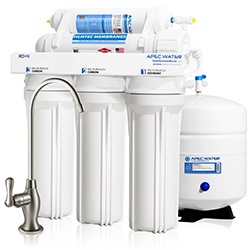
MECHANICAL FILTRATION OF DRINKING WATER
Mechanical filtration will remove almost all forms of turbidity. Of course, the smaller the turbid particles, the finer must be the filter openings in order to strain them out. Under some circumstances, the openings have to be so small that they cause an excessive pressure drop as the water percolates through the filter, and the unit may be impractical. In many cases filters containing specially graded and sized gravel and sand are effective in screening out turbid particles. With such units, periodic backwashing to remove the filtered material is all the maintenance necessary.
Some filter manufacturers also provide a "filter-aid" which is added onto the top of the filter bed immediately after backwashing. The filter-aid traps fine dirt particles, producing more sparkling clear water and keeps dirt from penetrating the filter bed, insuring better bed cleansing during backwashing. In some cases cartridge filters are effective. These will filter water used for cooking and drinking. Generally, these cartridge filters are just installed on the drinking water lines.
There are several reasons for this: (1) they produce a significant pressure drop. This would be a handicap if these filters were installed on the main water line. (2) Their replacement cost may be too high to justify their use in filtering all the water.
Municipal and industrial systems frequently make use of the coagulation process to aid in the removal of turbidity. In this economical process a coagulating agent, such as aluminum sulfate, is fed into the water. After rapid mixing, the coagulating agent forms a "floc" generally in the form of a gelatinous precipitate. This floc gives the appearance of a soft, gentle snowfall.
A settling period is then needed to allow the floc to fall gently through the water. As the floc forms and settles, it tends to collect or entrap the turbid particles and form them into larger particles that sink to the bottom. On large installations settling basins provide the necessary time and space for the process. After the settling period, the water flows through a filter to remove the last traces of the coagulant and any remaining turbid particles.
Small coagulation-filtration systems are sometimes utilized for household purposes when turbidity is particularly offensive. The difficulties with the use of this process for home purposes are in determining what type of coagulant will give the best results, and what equipment is required.
Experience in this area is essential because the chemical properties of the water must be considered in relation to the coagulant or combination of coagulants employed. Further, adequate mixing and coagulation times are essential. Coagulation-filtration also requires considerably more attention to maintenance than do the simple filtration processes mentioned earlier.
According to recent news and reports, most tap and well water in the U.S. are not safe for drinking due to heavy industrial and environmental pollution. Toxic bacteria, chemicals, and heavy metals routinely penetrate and pollute our natural water sources making people sick while exposing them to long-term health consequences such as liver damage, cancer, and other serious conditions. We have reached the point where all sources of our drinking water, including municipal water systems, wells, lakes, rivers, and even glaciers, contain some level of contamination. Even some brands of bottled water have been found to contain high levels of contaminants in addition to plastic chemicals leaching from the bottle.
A good water filtration system installed in your home is the only way to proactively monitor and ensure the quality and safety of your drinking water. Reverse osmosis water purification systems can remove 90-99% of all contaminants from the city and well water to deliver healthy drinking water for you and your family.
Related Articles:
- Water softener alternatives
- Oxygen in drinking water
- Silica in drinking water
- Sodium/methane/ phenol
- Turbidity of drinking water
- Mechanical filtration
- Multi-media (depth filters)
- Color of drinking water
- Self maintenance guideline for private well owners
- Water pressure matters
- pH value of water
- Swimming/chlorine: protecting your skin and hair
- Common water usage of a household
- Public water systems users
- The guardian-Safe Drinking Water Act
- The correct disinfection practice
- Facts on home water treatment
- Lead in your drinking water?
- Arsenic in your drinking water
- Read the bottled water label
- Common bottled water treatment II
- State certified lab for water testing
- Popular filtration methods explained
- Myth on minerals and water
- Hard and soft water
- Earth water distribution
- A natural setting for fishs
- Experiment1-water cycle purify our drinking water
- Experiment2-pollution
- Experiment3-waster filtration
- Experiment5-pollution control by using carbon
- Experiment6-chlorination for disinfection
- Experiment7-organisms in source water
- Backcountry water drinking
- Hard water explained
- Alkalinity of water
- Filtration OR Purification?
- Cl2 resistant pathogens
- Common contaminants in the water system
- The origination of modern water filtration
- Define Spring water & the safety
- Water quality issues in Europe
- Seawater drinkable?
- How do water treatment plants work
- How does Hydrology affect water
- Barriers to quality water source management
- Coliform bacteria affect water quality






